With the design and development of the AR-15 in the 1950s and 1960s, Eugene Stoner was able to begin the process of bringing the world a truly modular rifle. Originally offered through the Armalite Company (AR stands for Armalite Rifle), Colt Manufacturing bought the production rights and the U.S. military adopted the rifle. Various companies over the years have been selected to OEM different sub-assemblies. For that to work, especially as world militaries started buying AR-15/M-16 style weapons from other manufacturers, the various parts had to be interchangeable, no matter the producer. The dimensions and qualities of the parts were set, in large part, by the U.S. military and have become known as “mil-spec” — short for military specifications.
There is no way of telling exactly how many companies produce mil-spec parts for the AR system, but there are many. Everyone is looking to build a better mousetrap, so we have tons of barrels, triggers, handguards, pistol grips, sights, and much more available. Still, the base component onto which everything else is attached is the lower receiver — the part that houses the fire-control system and on which the buttstock, pistol grip, and trigger hang. We saw what seemed to be essentially the same part being offered for prices ranging from $89 or so to several hundred dollars. We wondered why and what the differences were in these lower receivers. So, we secured four different stripped lowers from Brownells, ranging in price from $89 to $289. They were the Anderson Manufacturing AM-15 (Brownells order number 100-016-811), $86; the 17 Design 17-DM15 (100-041-549), $130; the Brownells (Retro) BRN-601 (078-000-359), $150; and the SilencerCo SCO-15 (100-041-063), $250. We should note these were all serialized lowers shipped to an FFL and logged into the FFL’s books, as required by law. Serial-numbered lower receivers are firearms, according to federal law, and must be transacted as if they were complete firearms.
Then we gathered up a set of common parts to fit and swap onto the lowers. They were a Carbine Length Recoil Spring (739-000-005), $11; a Mil-Spec 6-Position Buffer Tube (078-000-625), $28; an Ergo Tactical Grip (749-004-938), $36; a Carbine Mil-Spec Stock Completion Kit (080-000-555), $60; a Rise Armament RR434 Trigger (100-040-275), $160; and a Mission First Tactical AR-15 Battlelink Minimalist Stock (100-018-066), $51.
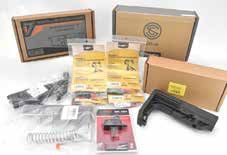
We used 10-round Stoner magazines that were designed for and labeled 6.5 Grendel, because the 6 ARC chambering is essentially a necked-down 6.5 Grendel. There are also 15- and 25-rounders available. The Stoner mags have a skosh more internal length available, which allowed our reloaded rounds to have the bullets seated that same skosh longer. For the careful, experienced reloader, that can add a hair more powder without going over pressure limits. Each 10-round magazine was $15 (MidwayUSA.com, 360264). So, in the aggregate, a complete set of test components cost $361. Of course, you will want more magazines, so add those to the overall price.
The completed lowers were then joined with a $949 CU-6MM-ARC upper assembly from Odin Works. Using the same upper assembly (upper receiver, bolt carrier group, barrel, fore end, gas tube, and gas block) and the same internal parts kits (a single trigger, pistol grip, buffer-tube assembly, and buttstock) allowed us to home in on variances in the lowers themselves. This brings the total non-lower parts price to $1310.
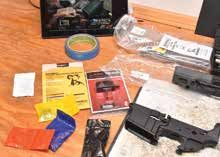
The Odin Works CU-6MM-ARC upper sported an 18-inch barrel with a 15.2-inch handguard. This particular upper was chambered for the recently introduced 6mm ARC cartridge. Odin’s stainless barrel has a 1:7.5-inch twist, and the standard rifle-length gas tube is adjustable using a provided tool on the knob at the forward end of the gas block. The muzzle is threaded 5⁄8×24 and is ready for a muzzle brake (not that the 6 ARC really needs one) or a suppressor. The racy-looking handguard is very light. It has Picatinny-rail sections at the rear and front as well as M-Lok slots at 3, 6, and 9 o’clock. QD attachment points are also available at the 3 and 9 o’clock positions. The fore end uses six screws to secure it tightly to the upper receiver. The bolt-carrier group was black-nitride finished aluminum and the key was properly staked. All told, we were very pleased with the Odin Works upper.
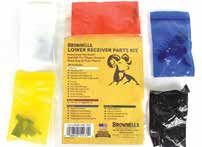
To help us wring out the best possible accuracy, we selected one of the brand-new Crimson Trace Hardline Pro 6-24x50mm 30mm scopes, a first-focal-plane optic with a mil-radian reticle, $900 (Brownells 100-044-902). Crimson Trace, well known for its laser sights, recently stepped into the consumer optics market. The company’s initial offering consisted of some 50 different scopes. We found the glass clarity to be very good, easily picking out a 10-inch plate through the mirage of a Texas summer at 600 yards. Adjustments were crisp and precise, while the MR1-MIL reticle did a great job of helping us hold off for wind calls on several blustery days.
6mm ARC Cartridge
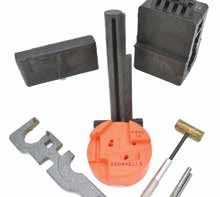
For this test we settled on the relatively new 6mm ARC cartridge from Hornady. Our military has been using the 5.56mm round for most of 60 years now. It also seems the soldiers have been trying to find a more powerful cartridge, still suitable for the AR-15/M-16 platform, for about the same amount of time. The 6mm ARC is the latest in that line of experiments, and we wanted to check it out.
The 18-inch barrel on the Odin Works upper we used propels a 108 Hornady ELD-M at about 2600 fps. That yields right at 1600 foot-pounds of energy at the muzzle, compared to about 1300 foot-pounds at the muzzle for a 5.56-caliber 77-grain bullet at 2800 fps. By 500 yards, this 5.56 bullet is down to about 500 foot-pounds of energy, and it goes subsonic at about 850 yards. The 6mm ARC bullet we tested has 500 foot-pounds of energy well past 800 yards and stays supersonic to around 1100 yards. That is obviously a lot more energy down range and a much more easily predicted trajectory.
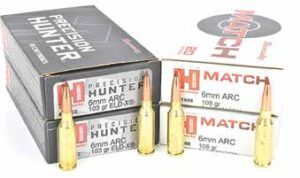
Do we think that the U.S. military is going to replace the 5.56 with the 6mm ARC next year? No, but we hear they like it, and we think that target shooters, competitive shooters, and hunters should take a look at it.
Before we proceed, we should note that assembling an AR-15 from parts is a technical job and only serious, experienced shooters should attempt it. It’s a good idea to review various AR-15 books and videos — before you start buying parts — to see if it’s something you really want to tackle. Also, your first build will go much more smoothly if you enlist the help of a shooting buddy who’s done at least one before. With those caveats and yeah-buts out of the way, now we’re on to the lowers themselves.
Anderson Manufacturing AM-15 100-016-811, $86
We started with the least expensive lower, looking hard to spot any cost-cutting measures. All the parts installed easily. With the right tools and a good rifle bench block from Brownells (080-000-492, $19), roll pins inserted easily and stayed where they were supposed to. Working parts like the magazine release and the bolt stop installed easily and worked smoothly.

The Anderson is made of 7075-T6 aluminum — just like the other lowers. In this case, the lower was forged (versus billet, like a couple of the others). Some think that makes the metal more durable. The process does do a good job of producing a minimum amount of metal, already in approximately the correct shape, ready for final fitting. Forging also limits options to a certain degree. Extra features, such as a larger opening for the magwell, are much more difficult to add. Our scale measured the weight at 8.5 ounces.
The lower was finished, as were all the lowers tested, with a Type III Hard Coat Anodize process. The magazine well is slightly beveled, as mil-spec lowers are supposed to be. This is a modern iteration of the lower receiver and that includes the “fence” of raised metal around the magazine release. The mag release, bolt release, and safety are set up to be single-sided. Even the markings for Fire and Safe on the safety are left side only. The trigger guard comes in the standard configuration with the flat bottom piece — no extra room for gloved hands here.

We compared the Anderson lower to a Rock River Arms complete lower that we had on hand. Other than the font used for the markings on the safety selector and the brand, serial number, etc. on the left-front of the mag well, we really couldn’t tell the two receivers apart. We thought that was a good sign.
Function was perfect, and everything we put in it fed flawlessly. The Stoner mags were a bit tight for the magwell and, sometimes, had to be gently persuaded to drop free. We tested with 10-round and 25-round mags though we just found out 15 rounders are now available. The average 5-shot group at 100 yards was 1.18-inch which we thought was just fine out of an AR platform. The Hornady 108-grain ELD-Match ammo averaged .98-inch for five rounds with a best group of just 0.60 inches.
Our Team Said: Was there a difference in the materials used? Nope. Were the parts a little harder to fit on the Anderson versus the SilencerCo? Nope. Was there a problem with the finish? Nope. Were there more blemishes? None, so nope. No frills, no problems. The Anderson Manufacturing sample was a great rendition of what a baseline mil-spec lower should be.
17 Design and Manufacturing 17-DM15 100-041-549, $130
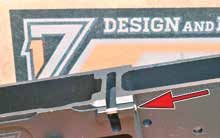
In contrast to the Anderson and Brownells lowers, the 17 Design was machined from a piece of billet aluminum. That process creates the opportunity to enhance the basic design of the AR-15 with a bit of customization. For example, with most forged lowers, edges, both vertical and horizontal, tend to be rounded. The CNC’d billet aluminum on the 17 Design has crisp, almost sharp edges. Some surfaces are raised, while others are lowered. The opening on the magwell has been beveled and opened a bit more. The base on the trigger guard is integral with receiver and is shaped to create an opening more suitable for large or gloved fingers. The 17 Design unit also provides a tensioning bolt located just aft of where the handguard attaches. The shooter can screw this bolt in to create a bit of pressure against the upper receiver, which can lead to increased accuracy. Instead of the three-sided fence protecting the magazine release, the 17-D sports more of a “gate,” with the raised area covering the forward (muzzle) end of the mag release along with vestigial wings of metal on the top and bottom.
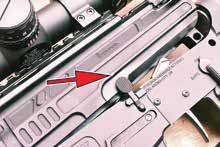
We encountered a very slight problem with the mag release mounted on the 17-D only when used in combination with the Odin Works upper. The Odin top end has some extra material reinforcing the bolt raceway on both side of the receiver. The bottom end of that is stylishly machined into a ledge. When we mounted it on the 17-D lower, we found that the bolt release did not have quite enough room to pivot properly and would sometimes fail to release the bolt when pressed. To see if this was a real problem with the 17-D lower, we mated that lower with other uppers (with rounded edges on the side) and had no problem dropping the bolt. It would appear this became an issue only when specifically combining the 17-D lower and the Odin upper. Mil-spec dimensions theoretically mean that properly sized parts should fit together and work perfectly. That is not always the case. We can also tell you about very good firearms that will find a brand of good ammunition they just refuse to feed. That doesn’t mean that anything was wrong with either one of them, only that that particular combination did not work that day. Sometimes you have to experiment a bit.
Other than the noted, occasional, issue with the bolt release, the 17-D lower worked perfectly with the Odin upper. The 17-D tied for second place in the accuracy tests with five-shot groups averaging 1.12 inches. It, like the Anderson lower, showed a slight preference for the 108-grain Hornady ELD-M ammo. The best group there was 0.97 inches and it averaged an overall 1.03-inch group.
Our Team Said: Made from billet aluminum with a racier look, the 17 Design lower brought several different features to the mix.
Brownells (Retro) BRN-601 078-000-359, $150
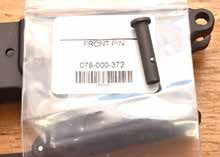
One of the prime directives for any company is to differentiate their products from that of the competition. The marketing department at Brownells has obviously been working overtime with their modern versions of 1960’s designs of semi-auto rifles. They have a prototype model that looks like the original Eugene Stoner offering of his iconic rifle, albeit in 5.56mm instead of the original 7.62mm chambering. Then they have the BRN-180 lower, which is a modernized version of the lower designed for the original AR-180 rifle — which was sort of an AR-15 without the long buffer tube and using stamped metal. They offer an M-16A1 style lower perfect for your semi-auto build of the shorty XM16-E1 version (you would need the shorter barrel with a permanently pinned muzzle brake). They also produce a lower receiver perfect for building the model so common in the mid-1960s. Toward that end, Brownells offers a retro handguard set (078-000-345, $40) and the proper 20-inch barrel assembly (100-020-999, $280) to go with that.
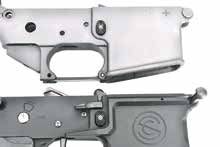
We stayed strictly with the retro lower finished in a nice, dark gray, thus matching the color of the originals. The primary differences in the early designs are on the right side of the lower receiver. Gone is the fence around the magazine release, and the whole right side is essentially a slab with a single step. Take note that the detent spring arrangement for the forward takedown pin is different for this model. That means that the proper front pin (078-000-372, $16) must be ordered to complete this build. As with the other lowers we tested, the single-sided safety is released through a 90-degree turn, and the magwell is slightly flared. The bottom of the trigger guard on this retro model hinges and can be released to allow access for gloved hands. As with the Anderson Manufacturing unit, the BRN-601 is forged aluminum finished with a hard-coat anodizing process. Don’t worry — the BRN-601 may have a look from days gone by, but it works just fine with more recently designed parts.

We had an occasional minor issue with the magazine release. There was just a bit of play between the mag release and the cutout for same that sometimes allowed the mag release to bind at the forward tip against the lower. If we pressed anywhere near the forward end of the mag-release button, everything was fine. This may have just been an example of tolerance stacking or a small burr, but it became less common as the tests proceeded.
The Brownells lower tied with the 17-D for the second-place finish in accuracy results at an average five-shot group of 1.12 inch. It also preferred the 108-grain ELD-M, with an average group size of 0.98 inches and a smallest group coming at a tidy 0.79 inch.
Our Team Said: Designed in the style of the early M-16s, this lower receiver calls out to be completed in the retro look with an A-1 stock, a triangular handguard, and the open-cage flash suppressor reminiscent of the mid-1960s rifles.
SilencerCo SCO-15 100-041-063, $250
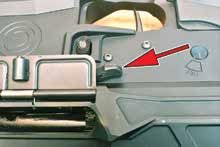
Like the 17 Design, the SilencerCo lower is machined from a billet of 7075-T6 aluminum then hard-coat anodized to a matte-black finish. The magwell has a deeper and wider flare than our other test samples, to go along with several very stylish cuts. Even so, the SCO-15 was the heaviest lower, coming in at 9.1 ounces. Once again on our billet receivers, the base of the trigger guard is integral with the receiver. The SilencerCo lower includes the company’s own ambidextrous bolt release. The mag release has the expected fence protection, but, just above that, is a cut from the top of the receiver through which extends a lever that allows the right index finger to easily drop the bolt. Of course, the bolt release on the left side of the receiver is still present, and the normal manual of arms can be used.
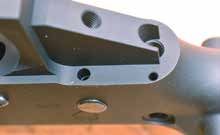
The SCO-15 adds two more interesting features in QD points, and those required a change we didn’t expect. The quick-detach mounts are located on the rear of the receiver about an inch behind the rear take-down pin. Mounts are provided on both sides and, because the Odin Works handguard also sports front and rear QD holes, setting up a two-point QD sling was easy and convenient. The QD point on the right rear required territory normally occupied by the detent and spring that normally impinges on the rear take-down pin. Because those tend to fall out when not under spring pressure, SilencerCo had to find a different solution. The method they decided upon involved drilling a second vertical hole immediately behind the one assigned to the detent pin and spring tensioning the safety. That required a bit more coordination as we attached the grip, thus capturing both springs simultaneously, but that was no big deal. The SCO-15 lower also comes with the threaded hole through which a bolt can be turned to apply pressure to the upper, and, perhaps, improve accuracy a bit. But they didn’t include the appropriate screw. Of course, we thought they should have.
Fit and function were excellent, and the look of this lower was distinctive. For a change, the SCO-15 preferred the Hornady 103-grain Elite Hunter, posting a smallest group of 0.88 inch and an average of 1.04 inch.
Our Team Said: The most expensive lower receiver in our tests, the SCO-15 offers several extra features. Only you can decide if those features are worth the money.
The Bottom Line
We were pleased with all four lower receivers in this test. The Anderson averaged 1.18 inches for all groups shot, the 17-Design and the Brownell’s averaged 1.12 inches, and the SCO-15 averaged 1.06 inches. Because all the groups were fired through the same upper and with the same lower parts, including trigger, we would have been very surprised if the group sizes had varied much at all. The net group size top to bottom was only 0.12 inch. We considered all of those to be very acceptable groups for an MSR platform, but we didn’t consider them to be statistically significant.
- Need to purchase a good lower receiver on a budget? The Anderson Manufacturing AM-15 should serve you well. We give it an A grade and think it’s a BEST BUY.
- Looking for a lower that’s a step up in price for offering a more distinctive look? The 17 Design 17-DM15 could well be for you. We give it an A- grade for the minor problem with the mag release.
- Are you a history buff trying to recreate a famous rifle from 60 years ago? You need to check out the Brownells Retro BRN-601 lower receiver. It, too, gets an A- grade for a minor problem with its mag release, but its look is unique.
- Do you want a few more features on your next match rifle, just to shave off a few tenths on your next run? By all means, look at the new SilencerCo SCO-15 lower. We give it an A grade and make it OUR PICK.
6mm ARC AR-15 Lower Receiver Specifications
| Manufacturer Model | Anderson AM-15 | 17 Design 17-DM15 | Brownells BRN-601 | Silencer Co SCO-15 |
| Brownells Part No. | 100-016-811 | 100-041-549 | 078-000-359 | 100-041-063 |
| Brownells Price | 86 | 130 | 150 | 250 |
| Material | 7075-T6 Aluminum | 7075-T6 Aluminum | 7075-T6 Aluminum | 7075-T6 Aluminum |
| Manufacturing Process | Forged | Billet | Forged | Billet |
| Finish | Type III Hard Coat Anodized | Type III Hard Coat Anodized | Type III Hard Coat Anodized | Type III Hard Coat Anodized |
| Weight | 8.5 oz. | 9.0 oz. | 8.0 oz. | 9.1 oz. |
Features
| Anderson AM-15 | 17 Design 17-DM15 | Brownells BRN-601 | Silencer Co SCO-15 | |
|---|---|---|---|---|
| Flared Magazine Well | l | l | l | l |
| Ambidextrous Bolt Release | l | |||
| Tensioning Screw | l | l |
Assembly Scores
| Anderson AM-15 | 17 Design 17-DM15 | Brownells BRN-601 | Silencer Co SCO-15 | |
|---|---|---|---|---|
| Fit | 5 | 5 | 5 | 5 |
| Finish | 5 | 5 | 5 | 5 |
| Function | 5 | 4 | 4 | 5 |
Range Data
| Hornady 108-grain ELD-M | Anderson AM-15 | 17-D 17-DM15 | Brownells BRN-601 | Silencer Co SCO-15 |
| Average Velocity | 2608 fps | 2590 fps | 2613 fps | 2628 fps |
| Muzzle Energy | 1632 ft.-lbs. | 1609 ft.-lbs. | 1638 ft.-lbs. | 1657 ft.-lbs. |
| Average Group | 0.98 in. | 1.03 in. | 0.98 in. | 1.08 in. |
| Best Group | 0.60 in. | 0.97 in. | 0.79 in. | 0.91 in. |
| Hornady 103-grain ELD-X | Anderson AM-15 | 17-D 17-DM15 | Brownells BRN-601 | Silencer Co SCO-15 |
| Average Velocity | 2599 fps | 2601 fps | 2626 fps | 2641 fps |
| Muzzle Energy | 1546 ft.-lbs. | 1548 ft.-lbs. | 1578 ft.-lbs. | 1595 ft.-lbs. |
| Average Group | 1.38 in. | 1.21 in. | 1.25 in. | 1.04 in. |
| Best Group | 1.24 in. | 1.07 in. | 0.85 in. | 0.88 in. |
Range data was gathered at American Shooting Centers in Houston. Muzzle velocities were determined via a LabRadar chronograph, $559. We fired multiple five-shot groups at 100 yards using a Caldwell TackDriver Pro (Brownells 100-027-023, $49) and a large rear bag from Tab Gear (TabGear.com, $34).





























I’ve built 6 AR’s from Poverty Pony (Anderson) ($49) receivers and other than looks I can’t figure out why anyone would pick anything more expensive. My last lower assembly was used on a Bear Creek 22 magnum upper and it does everything it’s supposed to. Another reason I like Anderson is they are made here in my home state of Kentucky. It’s also refreshing to see all 4 of the tested receivers get great marks. Thanks for the honest reviews Gun Test!
I would really like to see your assessment of products made and sold by Bear Creek Arsenal. I have a number of weapons from Bear Creek; AR 15s in 5.56; 6.5 Grendel; .450 Bushmaster; and 7.62×39, as well as an AR10 in .308. All of my BC rifles have performed flawlessly and I’ve been very impressed with them. Sure would like to see your assessment and evaluation against other manufacturers.